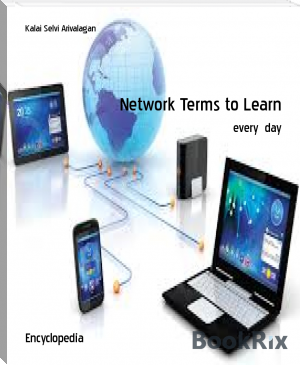Network Terms to Learn - Kalai Selvi Arivalagan (best love novels of all time .TXT) 📗

- Author: Kalai Selvi Arivalagan
Book online «Network Terms to Learn - Kalai Selvi Arivalagan (best love novels of all time .TXT) 📗». Author Kalai Selvi Arivalagan
Apache Ant
Apache Ant is a Java-based, open-source software build tool developed by the Apache Software Foundation. It is similar to the "make" utility, but is mainly functional on the Java platform. Unlike make, Ant scripts are written in XML to describe the build process and its dependencies. Portability and simplicity of use are two of the main benefits of Ant.
Virtual Telecommunications Access Method
Virtual Telecommunications Access Method (VTAM) is an IBM application programming interface that allows application programs to communicate or exchange data with external devices such as mainframes, communications controllers, terminals, etc. VTAM helps to abstract these devices into logical units so that developers do not need to know the underlying details of the protocols used by these devices.
Artificial Intelligence Engineer
An artificial intelligence engineer is someone who works on artificial intelligence problems or technologies. These IT professionals are part of a group that is in high demand as artificial intelligence and machine learning take off in various parts of the IT industry.
Chrestomathy
Chrestomathy is a certain type of comparative resource for computer programming. It involves looking at different kinds of program syntax side by side, to understand the semantics and structure of each programming language.
Access Governance
Access governance is the idea of managing individual user access in ways that protect networks and systems. It's the application of specific policy to access paradigms, and a broad overarching framework for how access works in a given digital environment.
Humane Tech
Humane tech is a term that refers to the goal of achieving technologies that aid humans in key human goals instead of exploiting humans for profit. The struggle for humane tech can also be construed as a movement to ensure that technology is contributing to the common good instead of harming human citizens in various ways.
Baseband Unit
A baseband unit (BBU) is a device in telecom systems that transports a baseband frequency, usually from a remote radio unit, to which it may be tied through optical fiber. BBUs are useful in a wide range of telecom systems that route data to user endpoints, as well as for different types of enterprise architectures.
Quantum Advantage
The term "quantum advantage" is used to describe how a quantum computer may be able to outperform a classical computer. Quantum advantage serves as a kind of conceptual example of how much better quantum computers can be at various tasks and processes, and why quantum computing should be pursued as a frontier of IT.
Squeak
Squeak is a language that is part of the Smalltalk set of object-oriented tools. It's sometimes called a "dialect" of Smalltalk that helps with cross-platform implementations, such as in some forms of virtualization.
Synthetic Data
Synthetic data is a fundamental concept in new data technologies that makes use of non-authentic, invented or automatically generated data that are not event-generated in the real world. In contrasting real and synthetic data, it's possible to understand more about how machine learning and other new forms of artificial intelligence work.
Bitcoin Lightning Network
The Bitcoin Lightning Network is a cryptocurrency protocol that works with blockchain ledger technology. It was created by Joseph Poon and Thaddeus Dryjain in 2017 and is now used to help manage cryptocurrencies such as bitcoin.
Dogecoin
Dogecoin is a dog-themed cryptocurrency pioneered in 2013, an alternative to more famous choices like bitcoin. Although the value of an individual Dogecoin is very small (often a portion of a cent) the massive number of Dogecoins in circulation correlates to a market capitalization of over $1 billion.
Self-Replicating Machine
Self-replicating machines are a category of autonomous robot that can make copies or reproduce themselves autonomously with the help of raw materials from the existing environment. The self-replicating machine is based on the concept of self-replication as found in the nature. Further development of the self-replicating machine concept is considered a critical part of many future plans, like the mining of asteroid belts and moons for minerals and ores.
Wearable Robot
A wearable robot is a specific type of wearable device that is used to enhance a person's motion and/or physical abilities. Wearable robots are also known as bionic robots or exoskeletons.
Predictive Maintenance
Predictive maintenance (PdM) is an approach to asset management that relies on operational data to determine when a physical asset requires service. An important goal of PdM is to minimize maintenance costs by preventing equipment failures before they occur.
Predictive maintenance plays an important role in industries that requires high availability (HA) for machine parts. PdM can be contrasted with reactive maintenance and preventive maintenance.
Reactive Maintenance – Run equipment until it breaks and then fix or replace it.
Preventive Maintenance – Replace parts and schedule equipment repairs on a time- or machine-run-based schedule.
Predictive Maintenance – Use intelligent sensors to monitor machine parts in operations and machine learning to determine when data has deviated from desired parameters.
Predictive maintenance software uses data produced by Internet of Things (IoT) and Industry 4.0 edge nodes to monitor the condition of mechanical assets as they are operating. Consumer-grade predictive maintenance software apps will typically issue an alert when data suggests a replacement part or maintenance appointment is needed.
In contrast, some enterprise-level PdM software applications are able to connect to other business systems and actually order replacement parts and set up appointments so repairs can be made. Popular enterprise PdM vendors include Fxix, UpKeep and eMaint.
Term of the day - 4 Chinese Wall
Chinese wall is a reverse engineering and cloning technique that captures copyrighted and patented processes for reconstruction. Chinese wall implementation provides a buffer against intellectual property infringement allegations via the clean room environment model specification implies that developers do not have access to competing intellectual property. Chinese wall references the Great Wall of China, erected to protect against invasion. Many legal ethics experts condemn the Chinese wall term as linguistic discrimination. Chinese Wall is also known as clean room design.
Memex
Memex is a conceptual data storage and retrieval system outlined by Vannevar Bush. Memex was intended to help people enhance their lives by providing access to the massive amount of knowledge already recorded. Bush realized that there was no easy way to navigate through this information and find all the documents or passages specific to one's reasons for searching. Memex was his solution to this problem. Memex is an important stepping stone in the creation of the Internet because it served as an inspiration to Ted Nelson, Douglas Engelbart and many of the others who contributed to the hypertext used on the World Wide Web today.
Critical Security Parameter
A critical security parameter (CSP) is data using a cryptography module to process encryption functions. Data includes passwords, security codes, cryptographic keys, personal identification numbers (PIN) and any other unprotected security information. Established information security rules protect CSPs, which are only accessible from authorized computer systems. CSPs obtained by unauthorized users pose security threats.
Dotsam
Dotsam is a slang term that refers to all the neglected areas of the Web that are still live despite not being maintained. Dotsam includes abandoned email accounts, and forgotten blogs, websites and social media profiles. The term dotsam is a combination of "dotcom" and "flotsam."It is also referred to as netsam.
Dogfooding
The term "dogfooding" is an IT slang for the use of one's own products. In some uses, it implies that developers or companies are using their own products to work out bugs, as in beta testing. One benefit of dogfooding is that it shows that a company is confident about its products.
Internet Society
The Internet Society (ISOC) is an international nonprofit organization that handles Internet standards, education and policy development. Founded in 1992, ISOC's mission is to ensure open Internet development by enhancing and supporting Internet use for organizations and individuals worldwide.
Dual Inline Memory Module
A dual inline memory module (DIMM) is a small-scale circuit board that holds memory chips on the motherboard. DIMM incorporates a series of memory called dynamic random access memory (DRAM), which provides primary storage, the main memory that continually reads and executes stored instructions or data directly to the CPU. DIMM is an attempt to improve on the earlier single inline memory module (SIMM), which used matched pairs. DIMM uses only one circuit board, thus increasing memory speed and storage. DIMM also has a much smaller circuit board and easier insertion compared to SIMM.
Phubbing
Phubbing is a term created by the combination of the words phone and snubbing. It refers to a person interactiing with their phone (or other device) rather than interacting with a human being. The use of this, and other terms around mobile device use, showcases a growing issue with different kinds of technology, including the delicate balance of sharing time and attention when facing two very different interactions at the same time.
IP Datacasting
IP datacasting is a broadcast technology that helps in transmitting digital multimedia and services like games, files and computer applications to mass audiences. Considered a cost-effective and efficient technology for distribution, the technology takes full advantage of broadcast media's distribution capabilities with simultaneous receipt of content, which is made possible through a large coverage area.
Cloud Orchestration
Cloud orchestration describes the arrangement of cloud automation processes to serve particular goals. Where cloud automation typically handles a single task, cloud orchestration helps to automate collections of tasks and generally streamline business processes.
Backpropagation
Backpropagation is a technique used to train certain classes of neural networks – it is essentially a principal that allows the machine learning program to adjust itself according to looking at its past function. Backpropagation is sometimes called the “backpropagation of errors.”
Sparse Autoencoder
A sparse autoencoder is one of a range of types of autoencoder artificial neural networks that work on the principle of unsupervised machine learning. Autoencoders are a type of deep network that can be used for dimensionality reduction – and to reconstruct a model through backpropagation.
Java Swing
Java Swing is a lightweight Java graphical user interface (GUI) widget toolkit that includes a rich set of widgets. It is part of the Java Foundation Classes (JFC) and includes several packages for developing rich desktop applications in Java. Swing includes built-in controls such as trees, image buttons, tabbed panes, sliders, toolbars, color choosers, tables, and text areas to display HTTP or rich text format (RTF). Swing components are written entirely in Java and thus are platform-independent.
Denoising Autoencoder
A denoising autoencoder is a specific type of autoencoder, which is generally classed as a type of deep neural network. The denoising autoencoder gets trained to use a hidden layer to reconstruct a particular model based on its inputs.
Boosting
The process of boosting involves improving the power of a machine learning program by adding more complex or capable algorithms. This process can reduce both bias and variance in machine learning, which helps to create more effective results.
Modular Object-Oriented Dynamic Learning Environment
A modular object-oriented dynamic learning environment (Moodle) is an open-source software that provides the ability to create, deploy and manage e-learning websites and applications. Modular object-oriented dynamic learning environments are a type of learning management system (LMS) or online learning system (OLS). They were initially developed by an educator and are now maintained by Moodle Community and Moodle HQ.
Markov Decision Process
A Markov decision process (MDP) is something that professionals refer to as a "discrete time stochastic control process." It's based on mathematics





Comments (0)